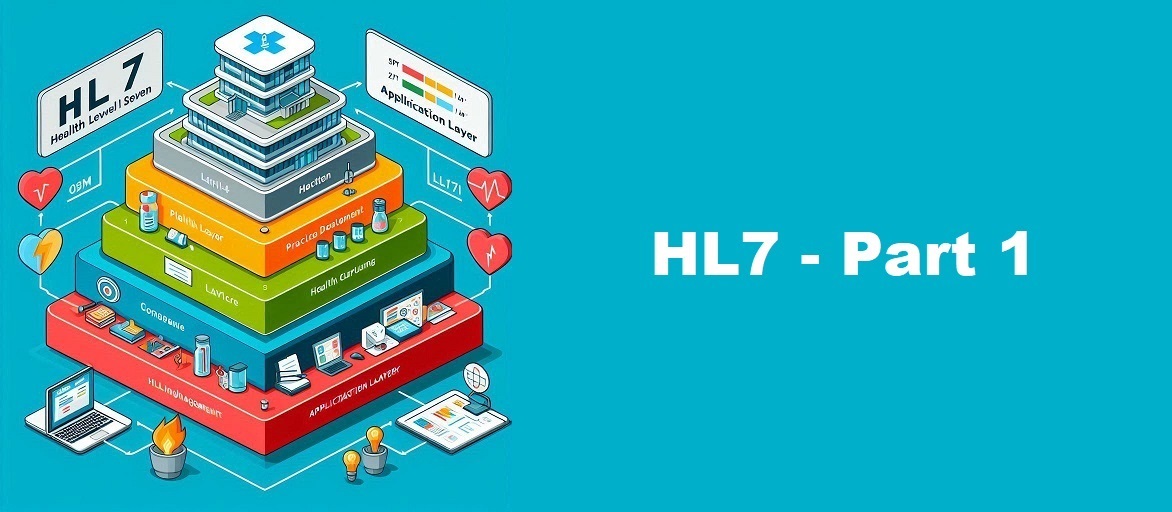HL7 - Health Level Seven

The Importance of HL7 in Modern Healthcare
Real-Time Needs in Hospital Settings
In today’s fast-paced healthcare environment, hospitals require efficient and real-time communication between various departments and systems to provide the highest quality of patient care. This involves the seamless exchange of patient information across different platforms such as Practice Management (PM), Electronic Health Records (EHR), and Laboratory Information Systems (LIS). Effective communication ensures timely diagnosis, treatment, and continuity of care, which are critical for patient outcomes and operational efficiency.
Different Parts of Hospital Information Systems
Practice Management (PM)

Practice Management systems are crucial for the administrative and financial operations of a healthcare facility. These systems handle patient registration, scheduling, billing, and other administrative tasks. Effective PM systems streamline operations, reduce errors, and enhance patient experience by minimizing administrative burdens.
Electronic Health Records (EHR)

Electronic Health Records are comprehensive digital versions of patients’ paper charts. EHRs provide real-time, patient-centered records that make information available instantly and securely to authorized users. They facilitate access to a patient’s medical history, diagnoses, medications, treatment plans, immunization dates, allergies, radiology images, and laboratory test results. EHRs play a pivotal role in improving the accuracy and clarity of medical records.
Laboratory Information Systems (LIS)

Laboratory Information Systems manage laboratory operations, including test ordering, specimen tracking, result entry, and reporting. LIS is essential for ensuring that laboratory processes are efficient, results are accurate, and information is disseminated quickly to relevant healthcare providers. Integration with EHR and PM systems is critical for coordinated patient care.
The Need for a Common Language
The integration of PM, EHR, and LIS is essential for creating a cohesive healthcare ecosystem. However, each of these systems often comes with its own unique schema and architecture, making interoperability a significant challenge. Developing interfaces and ensuring that systems can communicate effectively requires a deep understanding of each system’s intricacies, which can be time-consuming and resource-intensive. Hence we need some common way to do communicate between these systems. And, that’s what gave birth to HL7!
The Role of HL7
Health Level Seven (HL7) is an international set of standards for the exchange, integration, sharing, and retrieval of electronic health information. HL7 provides a framework for the exchange, integration, sharing, and retrieval of electronic health information. It sets the standards for data exchange to ensure that various healthcare systems can communicate effectively, regardless of their internal architecture.
How was the name HL7 coined?
The name HL7 stands for “Health Level Seven.” The “seven” in HL7 refers to the seventh layer of the International Organization for Standardization (ISO),seven-layer communications model for Open Systems Interconnection (OSI).
The Seventh Layer: Application Layer The seventh layer, or the Application Layer, is where HL7 operates. This layer is responsible for end-user applications and the interfaces they use to interact with network services. It includes protocols for resource sharing, remote file access, and, crucially for HL7, communication between software applications in different healthcare systems.
Thumbnail Image Creation and Prompt
https://designer.microsoft.com/image-creator
Create an infographic that visually represents HL7 (Health Level Seven) and its role in healthcare communication. The infographic should include the following elements: Title: “HL7 - Health Level Seven” OSI Model Reference: Illustrate the OSI model with a focus on the seventh layer, labeled as the “Application Layer,” highlighting that HL7 operates at this level. Key Components: Practice Management (PM): Show icons or images representing administrative tasks like patient scheduling, billing, and registration. Electronic Health Records (EHR): Depict digital patient records, including charts, history, and real-time data access. Laboratory Information Systems (LIS): Visualize lab tests, specimen tracking, and results reporting.
Prompt used for generating Practice Management Image
Create an illustration of a hospital receptionist managing Practice Management (PM) tasks at a front desk. Setting: A hospital reception area with a prominently displayed hospital logo. Characters: Receptionist: A friendly and professional-looking individual sitting behind a desk. Activities: Patient Reception: Show the receptionist greeting a patient who is approaching the desk. Appointment Scheduling: Illustrate the receptionist using a computer or scheduling book to manage patient appointments. Phone Communication: Include a phone on the desk with the receptionist either answering a call or taking notes from a patient’s call. Desk and Environment: Desktop Computer: Show a computer screen displaying a practice management software interface for scheduling appointments. Calendar or Scheduler: Display a visible calendar or scheduling software on the receptionist’s computer screen.
Prompt used for generating Electronic Health Records
Create an illustration depicting the concept of Electronic Health Records (EHR) in a healthcare setting. Setting: A modern hospital or clinic interior with visible medical equipment and a digital environment. Characters: Healthcare Professional: A doctor or nurse interacting with a computer screen. Patient: Optionally, include a patient either in the background or represented through a digital avatar. Activities: EHR Interface: Show a detailed and user-friendly computer interface displaying a patient’s electronic health record. Include sections such as medical history, medications, allergies, lab results, and treatment plans. Data Entry: Illustrate the healthcare professional entering or reviewing patient data on the EHR interface. Real-Time Updates: Highlight real-time updates or notifications on the EHR screen, indicating recent lab results or medication changes.
Prompt used for generating Laboratory Information System Image.
Create an illustration depicting the Laboratory Information System (LIS) in a healthcare laboratory setting. Setting: A modern laboratory with laboratory equipment and digital interfaces. Characters: Laboratory Technician: A lab technician or scientist working at a lab bench or computer workstation. Activities: Specimen Processing: Illustrate the lab technician handling specimens or samples at a laboratory bench. LIS Interface: Show a detailed and user-friendly computer interface displaying the LIS software. Include sections for test orders, specimen tracking, result entry, and reporting. Barcode Scanning: Depict the technician scanning barcodes on specimen containers for identification and tracking purposes. Data Analysis: Optionally, show screens with data analysis tools or charts for interpreting laboratory test results.
